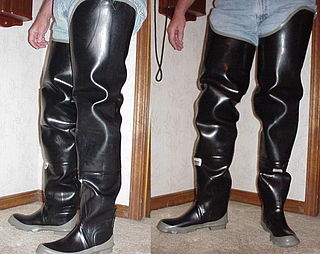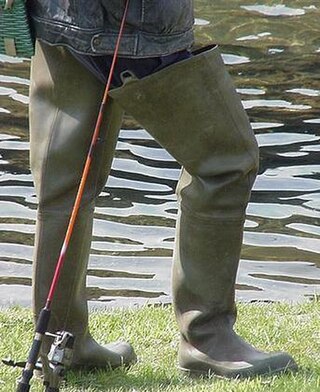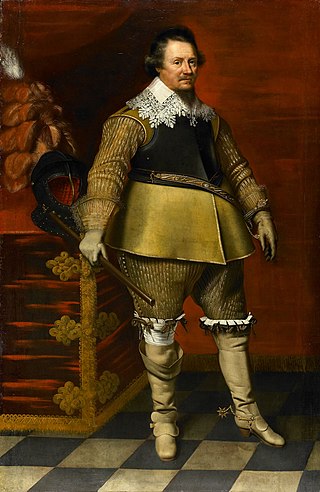
Poultry are domesticated birds kept by humans for the purpose of harvesting useful animal products such as meat, eggs or feathers. The practice of raising poultry is known as poultry farming. These birds are most typically members of the superorder Galloanserae (fowl), especially the order Galliformes. The term also includes waterfowls of the family Anatidae and other flying birds that are kept and killed for their meat such as the young pigeons, but does not include wild birds hunted for food known as game or quarry.

A boot is a type of footwear. Most boots mainly cover the foot and the ankle, while some also cover some part of the lower calf. Some boots extend up the leg, sometimes as far as the knee or even the hip. Most boots have a heel that is clearly distinguishable from the rest of the sole, even if the two are made of one piece. Traditionally made of leather or rubber, modern boots are made from a variety of materials.

The Wellington boot, often shortened to welly and also known as the gumboot, is a type of waterproof boot.

In anatomy, the thigh is the area between the hip (pelvis) and the knee. Anatomically, it is part of the lower limb.

Thigh-high boots, known also as thigh-length boots or simply thigh boots, are boots that extend above the knees to at least mid-thigh. Other terms for this footwear include over-the-knee boots, a name originally used for 15th century riding boots for men. These are sometimes called pirate boots, especially when cuffed. Over-the-knee boots are sometimes abbreviated to OTK boots. Lengths vary from reaching just over the knee to reaching almost to the crotch.

Hip boots, or hip waders as they are sometimes called, are a type of tall boot initially designed to be worn by river fishermen. Hip boots are typically made of rubber, they may also be made of PVC, nylon and/or polyester. Other materials, such as wool, cotton and foam, are used to add warmth and comfort. The boots completely cover the legs, up to the tops of the thighs or all the way up to the waist. Hip boots are designed to protect the wearer from water, and allow wading out into deeper waters. They also help to keep the feet and legs warm. Hip boots are also worn by many ecologists, environmental scientists, and aquatic biologists who do tests in swamps or lakes to determine the quality of water.

Boot fetishism is a sexual fetish focused on boots. Boots have become the object of sexual attraction amounting to fetishism for some people and they have become a standard accessory in BDSM scenes and a fashion accessory in music videos. Boots are seen as perhaps the most fetishistic of all footwear and boots are the most popular fetish clothing attire.

Knee-high boots are boots that rise to the knee, or slightly thereunder or over. They are generally tighter around the leg shaft and ankle than at the top. Originally made of leather, versions made of a synthetic rubber, they are used by fishermen, dairy workers, stable hands, duck hunters, clammers, etc. to protect the feet from water, mud, manure, etc. and to provide traction on slippery surfaces. Most slip on, but there are varieties with buckles or zippers, and those that lace up. They may, or may not, have high heels or platforms.

Breeches are an article of clothing covering the body from the waist down, with separate coverings for each leg, usually stopping just below the knee, though in some cases reaching to the ankles. Formerly a standard item of Western men's clothing, they had fallen out of use by the mid-19th century in favour of trousers.

In culinary terms, white meat is meat which is pale in color before and after cooking. In traditional gastronomy, white meat also includes rabbit, the flesh of milk-fed young mammals, and sometimes pork. In ecotrophology and nutritional studies, white meat includes poultry and fish, but excludes all mammal flesh, which is considered red meat.

A meat thermometer or cooking thermometer is a thermometer used to measure the internal temperature of meat, especially roasts and steaks, and other cooked foods. The degree of "doneness" of meat or bread correlates closely with the internal temperature, so that a thermometer reading indicates when it is cooked as desired. When cooking, food should always be cooked so that the interior reaches a temperature sufficient, that in the case of meat is enough to kill pathogens that may cause foodborne illness or, in the case of bread, that is done baking; the thermometer helps to ensure this.

Jodhpurs, in their modern form, are tight-fitting trousers to the ankle, where they end in a snug cuff, and are worn primarily for horse riding. The term is also used as slang for a type of short riding boot, also called a paddock boot or a jodhpur boot, because they are worn with jodhpurs. According to Tara Mayer, "Jodhpurs … exemplify the material and cultural exchanges between Britain and its Indian colony in the nineteenth and early twentieth centuries."

Waders denotes a waterproof boot or overalls extending from the foot to the thigh, the chest or even the neck. They are traditionally made from vulcanised rubber, but available in more modern PVC, neoprene and Gore-Tex variants. Waders are generally distinguished from counterpart waterproof boots by shaft height; the hip boot extending to the thigh and the Wellington boot to the knee. For the sake of emphasis, therefore, waders are sometimes defined by the extent of their coverage as thigh waders, chest waders or full-body waders. As a drysuit variant, full-body waders come with leaktight cuffs or gloves fitted to the sleeves and with a leaktight collar or hood fitted to the neck, enabling the wearer to remain dry when standing or walking in deeper water. Waders are available with boots attached or can have attached stocking feet, to wear inside boots, or inside swimfins in the case of float tube fishing.

Chicken is the most common type of poultry in the world. Owing to the relative ease and low cost of raising chickens—in comparison to mammals such as cattle or hogs—chicken meat and chicken eggs have become prevalent in numerous cuisines.

A ballotine is traditionally a de-boned thigh and/or leg part of the chicken, duck or other poultry stuffed with forcemeat and other ingredients. It is tied to hold its shape and sometimes stitched up with a trussing needle. A ballotine is cooked by roasting, braising or poaching. A ballotine is often shaped like a sausage or re-formed to look like the leg, often with a cleaned piece of bone left in the end.
Cavalier boots are a style of boot that were popular in Europe between approximately 1500 and 1700. They are soft knee-high leather boots typically made of brown calfskin.

The Booted Bantam or Dutch Booted Bantam is a European breed of true bantam chicken. It is characterised by abundant feathering on the feet and shanks, which gives it a "booted" appearance; and by vulture hocks, long stiff downward-pointing feathers on backs of the thighs, from which the Dutch name Sabelpoot ("sabre-legged") derives.

Over-the-knee boots, OTK boots, are long boots that fully or partly cover the knee. Originally created as a man's riding boot in the 15th century, in the latter part of the 20th century, the style was redefined as a fashion boot for women. Over-the-knee boots are also used as a work boot in circumstances requiring additional protection for the legs.
Kinky boots are boots, usually thigh-high boots, associated with boot fetishism.
















